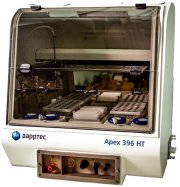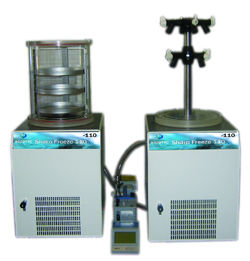|
 |
|
Recent Publications Little Peptide, Big Effects: The Role of LL-37 in Inflammation and Autoimmune Disease. JM Kahlenberg, MJ Kaplan, J Immunol. 2013, 191, 4895-901. DOI:10.4049/jimmunol.1302005. The innate immune system utilizes many approaches for defense against invading microorganisms, including complement-mediated lysis, engulfment, formation of neutrophil extracellular traps, and release of antimicrobial peptides. Although classically thought to be driven by adaptive immunity, the development of autoimmune diseases such as rheumatoid arthritis and systemic lupus erythematosus is increasingly associated with dysregulated innate immune pathways. An emerging theme within this literature is the contribution of antimicrobial peptides to the development of autoimmune disorders. This is best exemplified in atopic dermatitis and psoriasis where the defensins and the single human cathelicidin, LL-37, may contribute to disease. Furthermore, in the past few years, a role for LL-37 has emerged in the pathogenesis of systemic lupus erythematosus, rheumatoid arthritis, atherosclerosis, and possibly other diseases. In this review, we discuss the role of LL-37 and its murine ortholog, mCRAMP, in the modulation of immune and inflammatory pathways and their effects on autoimmune and inflammatory diseases. Design and synthesis of cationic antibacterial peptide based on Leucrocin I sequence, antibacterial peptide from crocodile (Crocodylus siamensis) white blood cell extracts. N Yaraksa, T Anunthawan, T Theansungnoen, S Daduang, T Araki, A Dhiravisit, S Thammasirirak, J Antibiot (Tokyo), 2013, Nov 6. DOI:10.1038/ja.2013.114. [Epub ahead of print] Leucrocin I is an antibacterial peptide isolated from crocodile (Crocodylus siamensis) white blood cell extracts. Based on Leucrocin I sequence, cationic peptide, NY15, was designed, synthesized and evaluated for antibacterial activity against Bacillus sphaericus TISTR 678, Bacillus megaterium (clinical isolate), Vibrio cholerae (clinical isolate), Salmonella typhi (clinical isolate), Salmonella typhi ATCC 5784 and Escherichia coli 0157:H7. The efficacy of the peptide made from all L-amino acids was also compared with all D-amino acids. The peptide made from all D-amino acids was more active than the corresponding L-enantiomer. In our detailed study, the interaction between peptides and the cell membrane of Vibrio cholerae as part of their killing mechanism was studied by fluorescence and electron microscopy. The results show that the membrane was the target of action of the peptides. Finally, the cytotoxicity assays revealed that both L-NY15 and D-NY15 peptides are non-toxic to mammalian cells at bacteriolytic concentrations. Inhibitory effect of short cationic homopeptides against Gram-positive bacteria F Guzmán, S Marshall, C Ojeda, F Albericio, P Carvajal-Rondanelli, J. Pept. Sci., 2013, 19, 792–800. DOI: 10.1002/psc.2578 In the selection or design of antimicrobial peptides, the key role played by cationic amino acids and chain length on the inhibitory potency and specificity is not clear. A fundamental study was conducted using chemically synthesized homopeptides of l-Lys and l-Arg ranging from 7 to 14 residues. Their effect on growth inhibition was evaluated over a wide range of Gram-positive bacteria at different levels of concentration. Interestingly, at lower concentrations (10 µM), Lys homopeptides with odd number of residues, especially with 11 residues, showed a broader inhibitory activity than those with even number of residues. At higher peptide concentrations (>20 µM), the inhibitory activity of Lys homopeptides was directly related to the number of residues in the chain. In contrast, Arg homopeptides, at lower concentrations, did not exhibit a defined pattern of bacterial inhibition related to the number of residues; however, at higher concentrations (>20 µM), the inhibitory effects were more pronounced. Lys homopeptides at concentrations up to 300 µM showed a remarkably lower toxicity against CHSE-214 cells. Arg homopeptides exhibited negligible cytotoxicity up to chain length of 11 residues at Antibacterial peptides often are exceptions because their activity does not involve receptor concentrations lower than 100 µM, but an abrupt increase in toxicity resulted when the peptide chain length reached 12 amino acid residues and higher concentrations. All synthesized homopeptides displayed characteristic polyproline II helix conformation in both buffer and liposomes, as shown by CD spectroscopy. This result suggests that short Lys homopeptides with an odd number of residues (9 and 11) have a broad spectrum of activity against Gram-positive bacterial cells compared with Arg homopeptides, which in turn showed a considerably higher selectivity toward those cells. By investigating the differences between Lys and Arg homopeptides, this study contributes to the understanding of their mechanism of growth inhibition and selectivity. Thus, it provides further guidelines for a rational design of short antimicrobial peptides. Copyright © 2013 European Peptide Society and John Wiley & Sons, Ltd. Selective Chromium(VI) Ligands Identified Using Combinatorial Peptoid Libraries AS Knight, EY Zhou, JG Pelton, MB Francis, J. Am. Chem. Soc., Article ASAP DOI: 10.1021/ja408788t Publication Date (Web): November 6, 2013 Copyright © 2013 American Chemical Society Hexavalent chromium [Cr(VI)] is a worldwide water contaminant that is currently without cost-effective and efficient remediation strategies. This is in part due to a lack of ligands that can bind it amid an excess of innocuous ions in aqueous solution. We present herein the design and application of a peptoid-based library of ligand candidates for toxic metal ions. A selective screening process was used to identify members of the library that can bind to Cr(VI) species at neutral pH and in the presence of a large excess of spectator ions. There were 11 sequences identified, and their affinities were compared using titrations monitored with UV–vis spectroscopy. To identify the interactions involved in coordination and specificity, we evaluated the effects of sequence substitutions and backbone variation in the highest affinity structure. Additional characterization of the complex formed between this sequence and Cr(VI) was performed using NMR spectroscopy. To evaluate the ability of the developed sequences to remediate contaminated solutions, the structures were synthesized on a solid-phase resin and incubated with environmental chromium contamination. The synthetic structures demonstrated the ability to reduce the amount of toxic chromium to levels within the range of the EPA contamination guidelines. In addition to providing some of the first selective ligands for Cr(VI), these studies highlight the promise of peptoid sequences as easily prepared components of environmental remediation materials.
|
|
New Year's Special To start the New Year, AAPPTec is offering 15% savings on Fmoc-L-amino acids, HATU, HBTU, TCTU, Rink amide resin and Fmoc-amino acid loaded Wang resins. Include the promotion code “New Year’s Special” on your order and AAPPTec will take 15% off the catalog price on qualifying products ordered by January 31. This special can not be used in combination with any other offer or discount. Special ends January 31, 2014. LL-37 LL-37 is a human antimicrobial peptide of the cathelicidin family and corresponds to the 134-170 segment of human cationic antimicrobial protein 18 (hCAP18). It plays an important role in the first line of defense against local infection and systemic invasion of pathogens at sites of inflammation and wounds. Cytotoxic to both bacterial and normal eukaryotic cells, LL-37 is significantly resistant to proteolytic degradation in solution. LL-37 is effective against multidrug-resistant Acinetobacter baumannii and prevents bacterial biofilm formation. (UHN Dürr, et al., Biochim. Biophys. Acta, 2006, 1758, 1408; F Neville, et al., Biophys. J., 2006, 90, 1275; Z Oren, et al., Biochem. J., 1999, 341, 501; K Ouhara, et al., J. Antimicrob. Chemother., 2005, 55, 888; X Feng, et al., Peptides, 2013, 49, 131; AJ Duplantier, ML van Hoek, Front Immunol., 2013, 4, 143; AS Jacobsen, H Jenssen, Future Med. Chem., 2012, 4, 1587).
Peptides composed entirely of D-amino acids are resistant to proteases and are potential leads for long acting peptide drugs (Welch, BD. et al. J. Virol. 2010, 84, 11235-44; Jung, HJ. et al. J. Microbiol. Biotechnol. 2008, 18, 990-6; Chalifour, RJ. et al. J. Biol. Chem. 2003, 278, 34874-81). All-D analogs of bio-active peptides often lack the activity of their mirror image models since they lack the proper three dimensional structure to bind with receptors. In fact, it was recently reported that the all-D isomer of an antibacterial peptide was more active than the native L isomer (N Yaraksa, et al., J Antibiot (Tokyo), 2013, Nov 6. [Epub ahead of print]).
Apex 396 HT The Apex 396HT is AAPPTec’s latest high throughput parallel peptide synthesizer. It can prepare up to 192 different peptides at the same time in standard titer plates. The Apex 396HT can prepare up to 96 peptides in larger quantities utilizing standard AAPPTec reactor assemblies. The Apex 396HT features four 800 mL reagent bottles and two racks each holding 36 amino acid vessels.
β-Amino Acids and β-Homoamino Acids Beta-amino acids and beta-homoamino acids incorporated into peptides can increase resistance to digestive enzymes, improve selectivity, enhance potency and increase metabolic stability. (K. Stachowiak, et al., J Med Chem. 1979, 22, 1128-30; KM Bromfield, et al., Chem Biol Drug Des. 2006, 68, 11-9; S Nordhoff, et al., Bioorg Med Chem Lett. 2009, 19, 6340-5; MA Ondetti, SL Engel, J Med Chem. 1975, 18, 761-3; D Janke, et al., Bioorg. Med. Chem., 2011, 19, 7236)
Sharp FreezeTM Lyophilizers
Sharp Freeze™ Lyophilizers can reach temperatures as low as –110 °C. When equipped with AAPPTec vacuum pumps which produce vacuums below 0.003 mbar, AAPPTec's freeze dryers provide fast, efficient lyophilization with a small, space saving footprint. Sharp Freeze lyophilizers are microprocessor controlled with overload and malfunction alarms. Digital models include built-in vacuum sensing to 0.001 mbar, digital readout and USB port for optional data logging. The condensers of Sharp Freeze lyophilizers are constructed of chemically resistant AISI 316 stainless steel. Optional glass inserts are available for corrosive solvents. Sharp Freeze lyophilizers are available with an optional electric de-icing function for rapid de-icing and cleaning of the condenser.
|
 |
UPCOMING EVENTS |
|
|
January 2014 PepTalk January 13-17 SLAS 2014 January 19-21 |
 |

